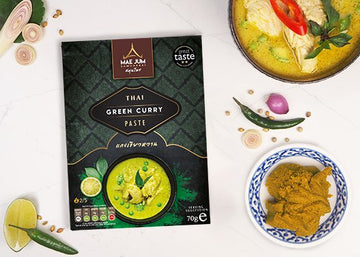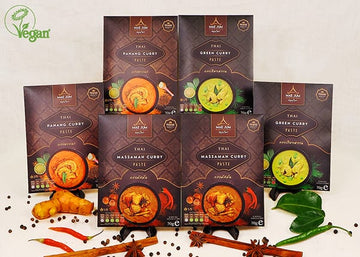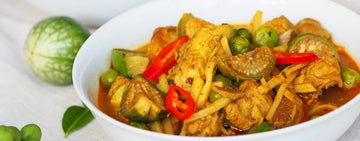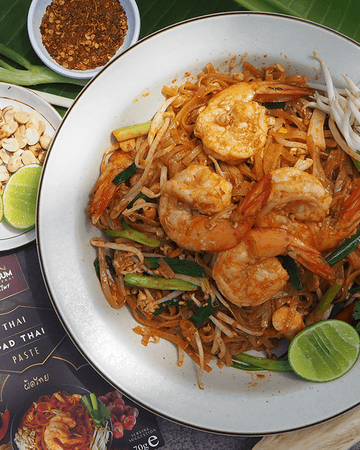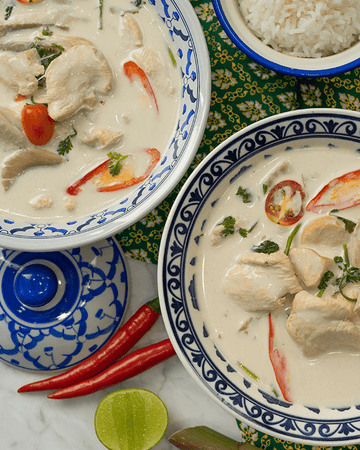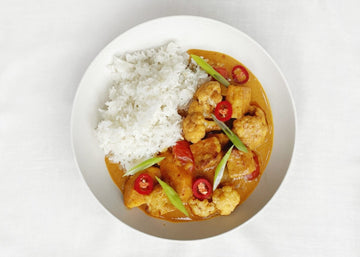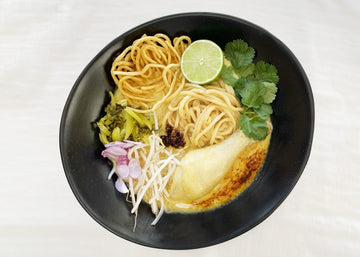Exploring the Bold Flavours of Traditional Thai Jungle Curry with Pork Ribs
Thai jungle curry is one of the lesser-known yet incredibly delicious dishes in Thai cuisine. Unlike many Thai curries that use coconut milk to create a creamy, mild sauce, jungle curry is distinct because it’s made without coconut milk. This creates a much lighter, broth-based dish that has a sharper, spicier flavour profile, perfect for those who love intense and vibrant flavours.
This blog will explore how to make a traditional Thai Jungle Curry with Pork Ribs, incorporating the essential Thai vegetables like green aubergines and pea aubergines (also known as turkey berries), along with bamboo shoots. The combination of tender pork ribs and crunchy vegetables, all simmered in a spicy, aromatic broth, makes this dish a flavour-packed delight.
The Origins of Jungle Curry
Jungle curry, or Gaeng Pa, originated in the northern regions of Thailand, where the dense forests and rugged landscapes dictated the availability of ingredients. The absence of coconuts in this region led to the development of this type of curry, which relies heavily on fresh herbs, vegetables, and spices for its bold taste.
The name "jungle curry" gives a clue to its nature—earthy, rustic, and packed with foraged vegetables like bamboo shoots, eggplant, and other wild greens. The broth is spicy, fiery, and incredibly aromatic, thanks to the blend of galangal, lemongrass, chillies, kaffir lime leaves, and curry paste.
While traditionally made with wild meats like boar, modern jungle curry recipes are versatile. You can use pork, chicken, duck, fish, or seafood. Today, we’ll focus on using pork ribs, which bring a deep, hearty flavour and texture to the dish.
Sourcing Traditional Thai Vegetables
One of the most delightful aspects of jungle curry is the use of unique Thai vegetables, especially green aubergines and pea aubergines. These vegetables are essential for adding texture and balancing the heat of the curry with a slightly bitter undertone.
Green aubergines are larger than their pea counterparts and can be cut into quarters to absorb the curry broth beautifully. Pea aubergines (also known as turkey berries) are smaller and provide a burst of crunch with each bite.
While these ingredients can be difficult to find outside of Thailand, they are available in Asian supermarkets or stores like Wing Yip, which have branches across the UK in Croydon, Manchester, Birmingham, and Cricklewood. Alternatively, you can shop online at places like Thai-food-online for these specialty items. If you can’t get your hands on Thai aubergines, you can substitute with regular baby aubergines or chopped purple aubergines.

Preparing the Pork Ribs and Vegetables
Before you begin cooking, it's important to prepare all the ingredients properly.
- Chopping the Pork Ribs: You’ll need a butcher-style knife to chop the ribs into manageable pieces, ideally 2-3 inches in length. Be sure to hold the ribs steady and cut through the bone carefully. If this feels like too much of a challenge, you can always buy pre-chopped ribs from your local butcher.
- Preparing the Aubergines: For Thai green aubergines, remove the stems and cut them into quarters. Once cut, place them in a bowl of cold water to prevent discolouration. The pea aubergines can be removed from their stems and rinsed under cold water.
- Bamboo Shoots: Bamboo shoots add a crunchy texture and subtle flavour to the curry. You can find them in cans or vacuum-sealed packs at Asian supermarkets. Simply rinse and slice them into strips before adding them to the dish.
Cooking Traditional Thai Jungle Curry with Pork Ribs
Now that your ingredients are prepped, it’s time to cook! This jungle curry recipe follows a traditional method, combining spicy Mae Jum Thai Jungle curry paste with pork ribs and vegetables.
Step 1: Fry the Curry Paste
Heat some oil in a wok or saucepan over medium to high heat. Add the Thai jungle curry paste and fry for 2 minutes, stirring constantly. This helps to release the aromatic flavours of the paste and enhances the depth of the curry.
Step 2: Season the Paste
Season the paste with fish sauce and palm sugar, which will balance the spiciness with salty and sweet notes. Stir the ingredients together until well combined.
Step 3: Add the Pork Ribs
Next, add the pork ribs to the wok, stirring to coat them evenly with the curry paste. This step ensures the meat begins absorbing the flavours right from the start. After about 2 minutes of stirring, add water to the wok, enough to cover the ribs.
Step 4: Simmer
Cover the wok and allow the pork ribs to simmer for 40 minutes over medium heat. The slow simmering process will tenderise the ribs and infuse them with the flavours of the curry paste.
Step 5: Add Vegetables
Once the pork ribs have simmered for 40 minutes, it’s time to add the Thai green aubergines, pea aubergines, and bamboo shoots. Stir them into the broth and allow everything to simmer uncovered for another 10 minutes. This helps the vegetables cook through while maintaining a slight crunch.
Step 6: Final Touches and Serving
When everything is cooked, serve the jungle curry in bowls, garnishing with fresh kaffir lime leaves and sliced red chillies for an extra burst of freshness and spice. Pair the curry with steamed Thai jasmine rice to soak up the flavours of the broth.

Why Jungle Curry Is Unique
One of the key aspects of Thai jungle curry is its lack of coconut milk. While many Thai curries are known for their creamy, rich texture due to coconut milk, jungle curry is different. The absence of coconut milk gives the dish a lighter, brothier texture and allows the spices, herbs, and vegetables to take centre stage.
This also makes jungle curry much lower in fat compared to coconut-based curries. It's a healthier option for those looking to enjoy bold, spicy Thai flavours without the richness of coconut cream.
Adjusting the Spice Level
Jungle curry is traditionally quite spicy, but you can adjust the heat to suit your taste. If you prefer a milder curry, use less curry paste or add extra water to dilute the intensity. For those who love spice, feel free to add extra Thai bird’s eye chillies or fresh red chillies as a garnish.
Final Thought
Thai Jungle Curry with Pork Ribs is a wonderfully rustic dish that brings the vibrant flavours of northern Thailand to your table. The combination of tender pork ribs, spicy curry paste, and fresh vegetables creates a satisfying, healthy meal that’s perfect for any occasion. While it may take a little time to prepare and simmer, the end result is worth every bite. So next time you’re craving something bold and aromatic, give this traditional Thai jungle curry a try!
If you enjoyed our traditional Thai Jungle Curry recipe, please give this recipe a star rating and comment if you loved the flavours of this traditional Thai dish! Check out our recipe page for more delicious dishes like this and subscribe for new recipes and posts. Always stay connected and follow us on Instagram and Facebook!
